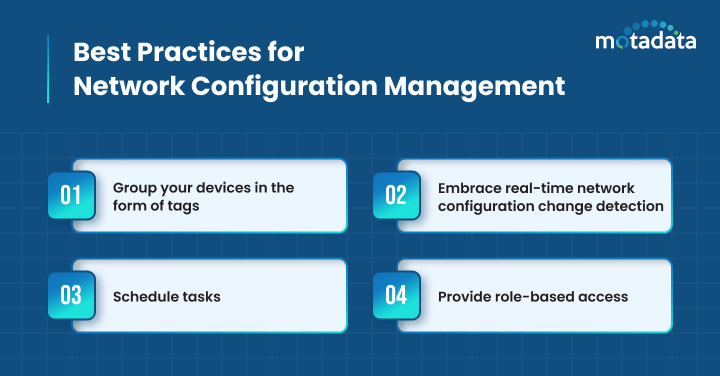Network configuration management is a discipline in IT that involves network configuration backups, network automation, configuration changes, crash recovery and auditing.
The blog is all about Network Configuration Management, how it helps any enterprise network of any size.
IT admins intend to use this guidance whenever they set up any network monitoring software (NMS) for use in their production environment.
As per the latest Gartner report on Network Configuration Management for Virtual & Cloud Infrastructures – Approximately 80% of all the network outages in any enterprise are due to manual human error, while only a small portion of outages are due to equipment failures, such as a faulty cable.
Most organizations generally consider Network Configuration Management once solutions for fault management and performance management are in place.
There are practical reasons to back it up.
To clearly understand this motive, you must have an understanding of the three key concepts of IT network management: Fault management, Performance management, and Configuration management.
While Network Configuration Management (NCM) will gradually have the maximum impact on the overall availability of network, it usually needs a lot of planning and is not measurable.
Deploying fault management & performance management systems, such as NMS, gives IT administrators’ immediate insight into the network performance and availability.
Once deployed, users can also measure the positive impact of network configuration management by doing so.
Why is it so important?
There’s a famous TVC that you might have seen. The auto mechanic in the scene is talking about a very costly engine repair that can be prevented if the customer replaces their faulty oil filter.
Auto mechanic says, “Either you can pay me now, or you can pay me later.” This quote here also applies for network configuration management.
Network Configuration Management is so crucial because it boosts the ability to scale IT infrastructure without correspondingly scaling up on IT administrative staff to manage those devices/ systems.
This makes it feasible to implement configuration management.
One of the greatest responsibilities of sysadmins and IT professionals is to make sure that the networks are functioning properly all the time.
Earlier managing network configurations used to be a pretty simple task, but not anymore. Monitoring resource utilisation and adjusting the appropriate tweaks whenever there is an occasional spike in traffic are just the basic tasks now.
As networks become complex, so does the task of managing them.
What are the benefits?
The main benefit of NCM is the consistency of software and systems. With network configuration management, you may no longer assume or hope that a network configuration is up to date, because if NCM is in place your configurations are obviously in the right state.
Some of the key benefits of NCM are as follows:
- Lower risk of network outages with network visibility and tracking of all the changes
- Reduce cost by preventing wasteful duplication of your IT assets & software engineering costs
- Improve customer experience by quickly detecting & rectifying improper network configurations
- Streamline processes by enforcing formal procedures for identification, monitoring, and auditing of IT assets
- Quick problem resolution with improved visibility and also provide users higher quality of service
- Efficient change management as you will know your right baseline configuration, and you’ll have visibility into ongoing design changes
- Faster service restoration in case of an outage, as your network configuration is already documented
What are the Best Practices for NCM?
If you’re using Motadata’s Network Monitoring Software, this list of best practices will be really helpful for you. Also, before you make any changes in your network, you must consider these questions:
- Does this update solve an issue relevant to my IT operations?
- Does this configuration change have any interdependencies?
- What’s the right process for implementing the change properly?
- Will this compromise my production environment in any way?
Not every configuration change is necessary for your IT operations. So, as a system admin, it’s for you to implement only those changes that are necessary.
We have listed a few of the best practices below:
- Group your devices in the form of tags: If you’ve a lot of network devices in your environment, grouping based on certain logical criteria might be handy for bulk operations.
- Embrace real-time network configuration change detection: Detection should be ideally done in real-time to set the things right.
- Schedule tasks: If you have a large network, carrying out processes like network backup, upload etc., gets monotonous, if it is done manually.
- Provide role-based access: In a multiple member work environment, it is mandatory to restrict access to sensitive configuration files.
Conclusion
Critical considerations in network configuration management are handling unexpected changes to your network. Motadata helps you discover, monitor, control, configure and audit all the changes to your IT systems, keeping your business secure.
Whenever you’re planning to implement a network monitoring software like Motadata, it’s critical to understand interdependencies of configuration management & how it can impact your system.
FAQs
Network configuration management typically involves tasks such as configuration backup and version control, change management, compliance auditing, automated provisioning, and network discovery and documentation.
Challenges may include manual and error-prone configuration processes, lack of visibility into network changes, configuration drift, compliance violations, difficulty in scaling with network growth, and complexity in managing heterogeneous network environments.




